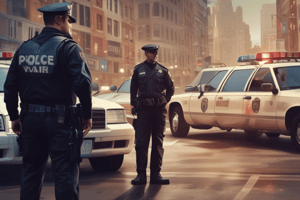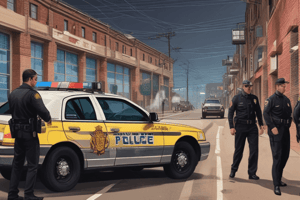Podcast
Questions and Answers
What are the three primary parameters to consider when firing at moving vehicles?
What are the three primary parameters to consider when firing at moving vehicles?
- Suspect's ability, officer's distance, and public opinion.
- Shooting accuracy, number of officers present, and time of day.
- Intent to harm, capability to harm, and proximity. (correct)
- Location of incident, nature of vehicle, and suspect's age.
What is the first action to take after an armed confrontation?
What is the first action to take after an armed confrontation?
- Secure the site of the confrontation. (correct)
- Call for backup.
- Conduct interviews with witnesses.
- File a police report.
Which of the following is NOT part of the procedures after an armed confrontation?
Which of the following is NOT part of the procedures after an armed confrontation?
- Evacuating the wounded.
- Conducting debriefing on involved operatives.
- Immediately releasing arrested suspects. (correct)
- Taking photographs.
What does the term 'beat' refer to in patrol operations?
What does the term 'beat' refer to in patrol operations?
What is the primary preparation focus for a patrol officer?
What is the primary preparation focus for a patrol officer?
In the context of patrol operations, what is a 'route'?
In the context of patrol operations, what is a 'route'?
What is the purpose of vehicle inspection before patrol?
What is the purpose of vehicle inspection before patrol?
What is the definition of a 'post' in patrol terminology?
What is the definition of a 'post' in patrol terminology?
What is a primary goal of the psychology of omnipresence in community policing?
What is a primary goal of the psychology of omnipresence in community policing?
What characteristic is essential for effective team policing?
What characteristic is essential for effective team policing?
How does team policing aim to improve police-community relations?
How does team policing aim to improve police-community relations?
What impact does team policing have on police morale?
What impact does team policing have on police morale?
Which of the following is NOT a potential effect of team policing?
Which of the following is NOT a potential effect of team policing?
What is a crucial aspect of team policing regarding officer interactions?
What is a crucial aspect of team policing regarding officer interactions?
What is the significance of public assistance in the team policing model?
What is the significance of public assistance in the team policing model?
In team policing, what is meant by 'unity of supervision'?
In team policing, what is meant by 'unity of supervision'?
What advantage does a bicycle patrol have over other types of patrol?
What advantage does a bicycle patrol have over other types of patrol?
What unique ability do police dogs have compared to human officers?
What unique ability do police dogs have compared to human officers?
Which of the following is not a use for canine patrols?
Which of the following is not a use for canine patrols?
What is a key characteristic of transactive planning?
What is a key characteristic of transactive planning?
What is one of the primary purposes of the Marine or Waterborne Patrol?
What is one of the primary purposes of the Marine or Waterborne Patrol?
Which patrol type is described as the oldest form of patrol after walking?
Which patrol type is described as the oldest form of patrol after walking?
Which of the following best describes the purpose of the SARA process?
Which of the following best describes the purpose of the SARA process?
What is an essential function of the assessment phase in the SARA process?
What is an essential function of the assessment phase in the SARA process?
What is the main role of the aircraft patrol?
What is the main role of the aircraft patrol?
Which type of patrol is specifically noted for its utility in large park areas?
Which type of patrol is specifically noted for its utility in large park areas?
Which type of planning emphasizes sensitivity to negative side effects?
Which type of planning emphasizes sensitivity to negative side effects?
What technology does WOLVES refer to in the context of canine patrol?
What technology does WOLVES refer to in the context of canine patrol?
What is the main focus of radical planning?
What is the main focus of radical planning?
Which of the following is NOT one of the SARA process steps?
Which of the following is NOT one of the SARA process steps?
In police planning, which doctrine covers specialized activities such as logistics?
In police planning, which doctrine covers specialized activities such as logistics?
Which primary doctrine represents the basic principles of planning in the PNP?
Which primary doctrine represents the basic principles of planning in the PNP?
Which type of operation primarily focuses on gathering information related to security and public safety?
Which type of operation primarily focuses on gathering information related to security and public safety?
What is the main purpose of Patrol Operations in the context of police work?
What is the main purpose of Patrol Operations in the context of police work?
In police operations, what differentiates Special Police Operations from regular law enforcement operations?
In police operations, what differentiates Special Police Operations from regular law enforcement operations?
Which operation includes the technical examination of evidence at a crime scene?
Which operation includes the technical examination of evidence at a crime scene?
What describes the role of objectives in operational planning?
What describes the role of objectives in operational planning?
What operation is primarily aimed at Counter-Insurgency and Counter Terrorist efforts?
What operation is primarily aimed at Counter-Insurgency and Counter Terrorist efforts?
Which operation involves the implementation of arrests and search warrants?
Which operation involves the implementation of arrests and search warrants?
What is the focus of Police Community Relations?
What is the focus of Police Community Relations?
Flashcards are hidden until you start studying
Study Notes
Parameters for Firing at Moving Vehicles
- Assess intent of suspects to harm police or civilians.
- Evaluate the capability of suspects to inflict harm.
- Consider proximity of suspects to officers and civilians.
Post-Incident Procedures
- Secure confrontation site and collect evidence.
- Photograph the scene for documentation.
- Assess ongoing threat levels at the location.
- Evacuate injured individuals to nearest medical facilities.
- Maintain the position of deceased individuals for investigation.
- Isolate arrested suspects from others.
- Conduct debriefings for all involved officers.
- File an after-operations report.
- Provide psychological support for involved personnel.
Patrol Overview
- Patrol: Essential police function, monitoring areas by foot or vehicle.
- Route: Designated streets for patrol, also called line beat.
- Beat: Specific area for patrol, can be on foot or in a vehicle.
- Sector: Collection of multiple beats or routes.
- District: Geographical subdivision of a city with its own station.
- Area: Territorial division within a larger city.
- Post: Assigned stationary location for officers.
Preparations for Patrol Operations
- Officer attitude is crucial for engagement with the community.
- Pre-patrol preparations include knowledge acquisition and equipment checks.
- Conduct vehicle inspections prior to patrol deployment.
- Engage in deb briefing before fieldwork with incoming officers.
- Familiarize with the assigned area through a district orientation.
Types of Patrol
- Foot Patrol: Oldest method, low cost, effective in congested areas.
- Bicycle Patrol: Cost-effective, stealthy, established in Manila in 1939, ideal for crowded areas.
- Canine Patrol: Dogs provide superior scent tracking, not a replacement for officers. K-9 teams outperform officers in searches.
- Horse Patrol: Useful in rough terrain and large areas, one of the oldest methods.
- Marine Patrol: Focuses on waterways for smuggling control and rescue operations.
- Aircraft Patrol: Economical resource use, includes helicopters for urban areas and fixed-wing for highways.
- Plain Clothes Patrol: Effective for undercover operations in high-crime regions.
Team Policing
- Concept developed in Aberdeen, Scotland, emphasizing community-police cooperation.
- Teams of 5-10 officers assigned based on crime concentrations.
- Promotes public participation and assistance with police efforts.
Psychological Strategy of Omnipresence
- Patrol officer presence can deter crime by instilling a sense of vigilance in the community.
Considerations in Operational Planning
- Goals: General intentions with set timeframes.
- Objectives: Specific measurable commitments within determined timelines.
SARA Process for Problem Solving
- Scanning: Identifying departmental and community issues.
- Analysis: Gathering and analyzing data related to identified problems.
- Response: Collaborating with agencies and individuals to address problems.
- Assessment: Evaluating the effectiveness of responses to measure outcomes.
Doctrine in Police Planning
- Fundamental Doctrines: Core principles guiding planning and management.
- Operational Doctrines: Rules determining PNP forces' roles in security operations.
- Functional Doctrines: Guidance for specialized activities within PNP operations.
Studying That Suits You
Use AI to generate personalized quizzes and flashcards to suit your learning preferences.




